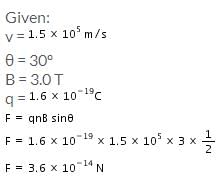All Exams >
EmSAT Achieve >
Physics for EmSAT Achieve >
All Questions
All questions of Magnetic Force for EmSAT Achieve Exam
An electron with a speed of 1.8 x 106 m/s is moving in a circular orbit in a uniform magnetic field of 10-4 Wb/m², the radius of the circular path of the electron is
- a)10.63 m
- b)1.063 m
- c)106.3 m
- d)0.1063 m
Correct answer is option 'D'. Can you explain this answer?
An electron with a speed of 1.8 x 106 m/s is moving in a circular orbit in a uniform magnetic field of 10-4 Wb/m², the radius of the circular path of the electron is
a)
10.63 m
b)
1.063 m
c)
106.3 m
d)
0.1063 m

|
Learners Habitat answered |
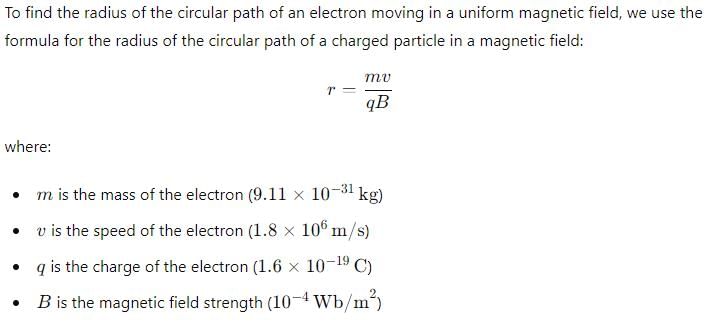
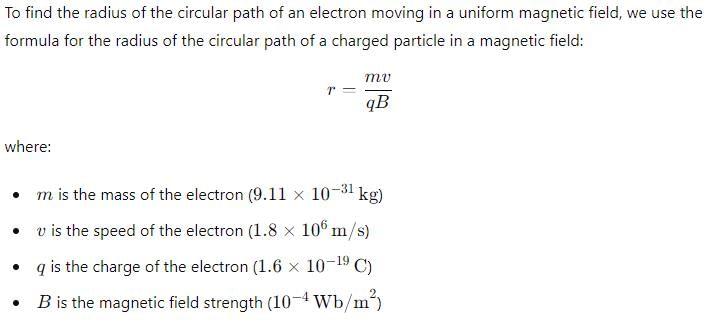
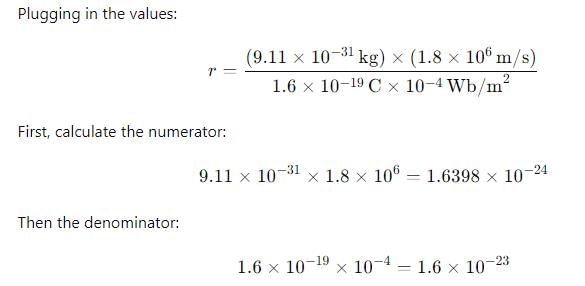
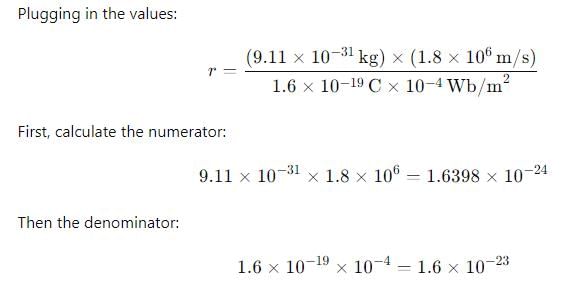
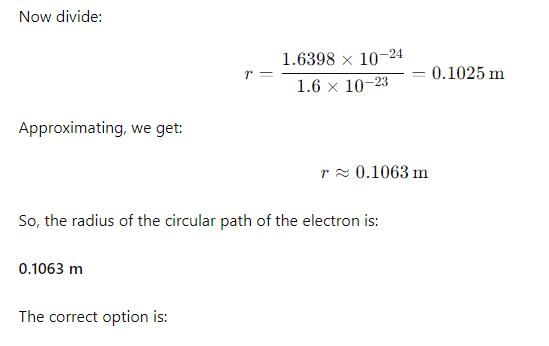
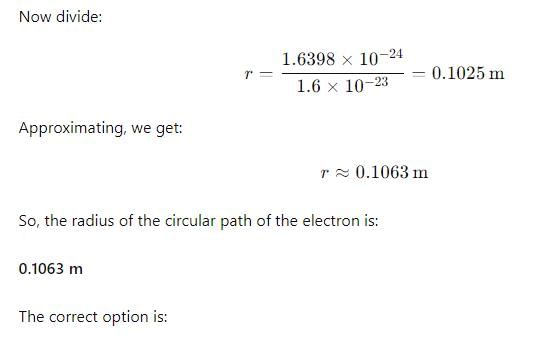
4. 0.1063 m
A proton with 1MeV kinetic energy is moving in a circular path of radius R in a uniform magnetic field. What should be the energy of an α – particle to describe a circle of same radius in the same magnetic field?- a)2 MeV
- b)0.5 MeV
- c)1 MeV
- d)4 MeV
Correct answer is option 'C'. Can you explain this answer?
A proton with 1MeV kinetic energy is moving in a circular path of radius R in a uniform magnetic field. What should be the energy of an α – particle to describe a circle of same radius in the same magnetic field?
a)
2 MeV
b)
0.5 MeV
c)
1 MeV
d)
4 MeV

|
Shraddha Singh answered |
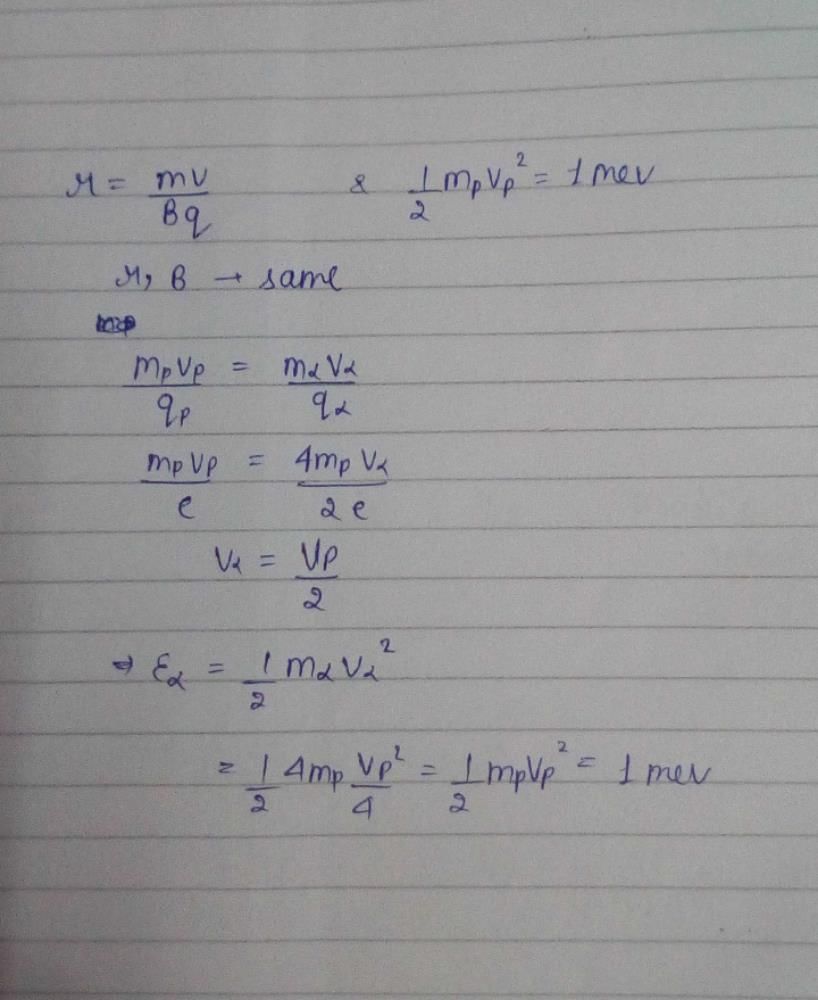
The frequency (v) of charged particle, moving at right angles to the magnetic field is independent of- a)radius of circular trajectory (r)
- b)magnetic induction (B)
- c)speed of the particle (v)
- d)both speed of the particle (v) and radius of trajectory (r).
Correct answer is option 'D'. Can you explain this answer?
The frequency (v) of charged particle, moving at right angles to the magnetic field is independent of
a)
radius of circular trajectory (r)
b)
magnetic induction (B)
c)
speed of the particle (v)
d)
both speed of the particle (v) and radius of trajectory (r).

|
Infinity Academy answered |
Frequency (v) = qB/2πm.
Frequency is independent of radius of trajectory of particle and speed of particle.
Frequency is independent of radius of trajectory of particle and speed of particle.
A particle of charge 1.6 x 10-19 C and mass 1.8 x 10-27 kg is moving around the path of radius 2 x 104 m with velocity 2.4 x 106 m/s. The magnetic field necessary is (in Wb/m²)- a)13.5 x 10-6
- b)135 x 10-6
- c)0.135 x 10
- d)1.35 x 10-6
Correct answer is option 'D'. Can you explain this answer?
A particle of charge 1.6 x 10-19 C and mass 1.8 x 10-27 kg is moving around the path of radius 2 x 104 m with velocity 2.4 x 106 m/s. The magnetic field necessary is (in Wb/m²)
a)
13.5 x 10-6
b)
135 x 10-6
c)
0.135 x 10
d)
1.35 x 10-6
|
|
Sreemoyee Choudhury answered |
Explanation:
When an electron is projected in a uniform electric field and a uniform magnetic field, both pointing in the same direction as the electron's velocity, the following happens:
1. Electric field:
The electric field exerts a force on the electron in the direction of the field. Since the electron is negatively charged, it experiences a force opposite to the direction of the electric field. Therefore, the electric field does not affect the direction of the electron's motion.
2. Magnetic field:
The magnetic field exerts a force on the electron perpendicular to both the field direction and the electron's velocity. The force is given by the Lorentz force equation:
F = q(v x B)
where F is the force, q is the charge of the electron, v is its velocity, and B is the magnetic field.
In this case, the force is directed inward, towards the center of the circular path. The magnitude of the force is given by:
|F| = qvB
where |F| is the magnitude of the force.
Since the force is perpendicular to the velocity, it causes the electron to move in a circular path around the magnetic field lines. The radius of the path is given by:
r = mv/qB
where r is the radius of the path, m is the mass of the electron, and v is its velocity.
3. Combined effect:
Since the electric field does not affect the direction of the electron's motion, the only effect is due to the magnetic field. As the electron moves in a circular path, it loses kinetic energy due to the work done by the magnetic force. Therefore, its velocity decreases in magnitude.
Hence, the correct option is D- The electron velocity will decrease in magnitude.
When an electron is projected in a uniform electric field and a uniform magnetic field, both pointing in the same direction as the electron's velocity, the following happens:
1. Electric field:
The electric field exerts a force on the electron in the direction of the field. Since the electron is negatively charged, it experiences a force opposite to the direction of the electric field. Therefore, the electric field does not affect the direction of the electron's motion.
2. Magnetic field:
The magnetic field exerts a force on the electron perpendicular to both the field direction and the electron's velocity. The force is given by the Lorentz force equation:
F = q(v x B)
where F is the force, q is the charge of the electron, v is its velocity, and B is the magnetic field.
In this case, the force is directed inward, towards the center of the circular path. The magnitude of the force is given by:
|F| = qvB
where |F| is the magnitude of the force.
Since the force is perpendicular to the velocity, it causes the electron to move in a circular path around the magnetic field lines. The radius of the path is given by:
r = mv/qB
where r is the radius of the path, m is the mass of the electron, and v is its velocity.
3. Combined effect:
Since the electric field does not affect the direction of the electron's motion, the only effect is due to the magnetic field. As the electron moves in a circular path, it loses kinetic energy due to the work done by the magnetic force. Therefore, its velocity decreases in magnitude.
Hence, the correct option is D- The electron velocity will decrease in magnitude.
The force acting on a charge q moving with velocity in a magnetic field
in a magnetic field is given by
is given by- a)

- b)

- c)

- d)

Correct answer is option 'C'. Can you explain this answer?
The force acting on a charge q moving with velocity in a magnetic field
in a magnetic field is given by
is given by
a)
b)
c)
d)
|
|
Neha Sharma answered |
The magnetic force on a free moving charge is perpendicular to both the velocity of the charge and the magnetic field with direction given by the right hand rule . The force is given by the charge times the vector product of velocity and magnetic field.
A Charge is fired through a magnetic field. The magnetic force acting on it is maximum when the angle between the direction of motion and magnetic field is- a)π
- b)zero
- c)π/2
- d)π/4
Correct answer is option 'C'. Can you explain this answer?
A Charge is fired through a magnetic field. The magnetic force acting on it is maximum when the angle between the direction of motion and magnetic field is
a)
π
b)
zero
c)
π/2
d)
π/4
|
|
Krishna Iyer answered |
The force will have a magnitude F=qvB sin q, thus it will be maximum if sin q is maximum. Thus, angle between velocity and magnetic field should be 90o or the charge particle moves perpendicular to the velocity vector.
When a charged particle moves in a magnetic field, its kinetic energy always- a)remain constant
- b)first increases then decreases.
- c)decreases
- d)increases
Correct answer is option 'A'. Can you explain this answer?
When a charged particle moves in a magnetic field, its kinetic energy always
a)
remain constant
b)
first increases then decreases.
c)
decreases
d)
increases
|
|
Rajeev Saxena answered |
The magnetic field does no work, so the kinetic energy and speed of a charged particle in a magnetic field remain constant. The magnetic force, acting perpendicular to the velocity of the particle, will cause circular motion.
Two straight horizontal parallel wires are carrying the same current in same direction, d is the distnace between the wires. You are povided with a small freely suspended magnetic needle. At which of the following positions will the orientation of the needle be independent of the magnitude of current in the wires?- a)At a distance d/2 from any of the wires.
- b)At a distance d/2 from any of the wires in the horizontal plane.
- c)Anywhere on the circumference of a vertical circle of radius d ans centre half way between the wires.
- d)At points half way between the wires in the horizontal plane.
Correct answer is option 'A'. Can you explain this answer?
Two straight horizontal parallel wires are carrying the same current in same direction, d is the distnace between the wires. You are povided with a small freely suspended magnetic needle. At which of the following positions will the orientation of the needle be independent of the magnitude of current in the wires?
a)
At a distance d/2 from any of the wires.
b)
At a distance d/2 from any of the wires in the horizontal plane.
c)
Anywhere on the circumference of a vertical circle of radius d ans centre half way between the wires.
d)
At points half way between the wires in the horizontal plane.
|
|
Nandini Patel answered |
The answer is d.
At these points, the resultant field =0
At these points, the resultant field =0
Chapter doubts & questions for Magnetic Force - Physics for EmSAT Achieve 2025 is part of EmSAT Achieve exam preparation. The chapters have been prepared according to the EmSAT Achieve exam syllabus. The Chapter doubts & questions, notes, tests & MCQs are made for EmSAT Achieve 2025 Exam. Find important definitions, questions, notes, meanings, examples, exercises, MCQs and online tests here.
Chapter doubts & questions of Magnetic Force - Physics for EmSAT Achieve in English & Hindi are available as part of EmSAT Achieve exam.
Download more important topics, notes, lectures and mock test series for EmSAT Achieve Exam by signing up for free.
Physics for EmSAT Achieve
208 videos|329 docs|212 tests
|

Contact Support
Our team is online on weekdays between 10 AM - 7 PM
Typical reply within 3 hours
|
Free Exam Preparation
at your Fingertips!
Access Free Study Material - Test Series, Structured Courses, Free Videos & Study Notes and Prepare for Your Exam With Ease

 Join the 10M+ students on EduRev
Join the 10M+ students on EduRev
|

|
Create your account for free
OR
Forgot Password
OR
Signup to see your scores
go up within 7 days!
Access 1000+ FREE Docs, Videos and Tests
Takes less than 10 seconds to signup


